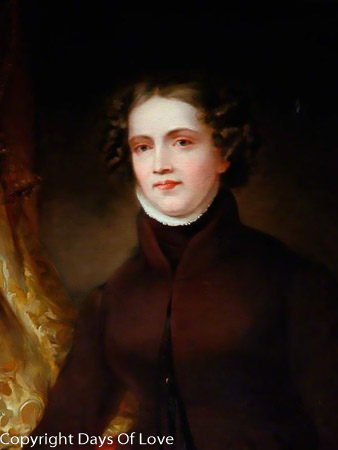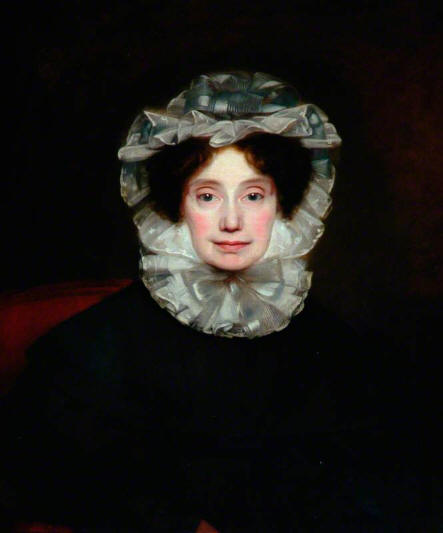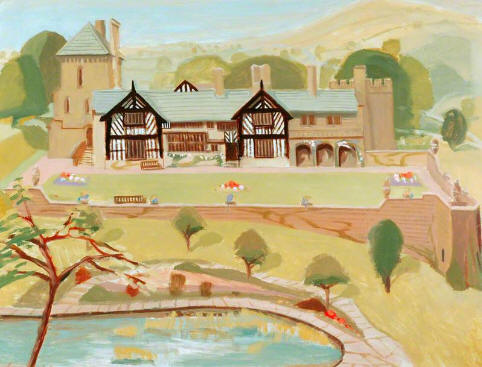Partner Eliza Raine, Ann Walker
Queer Places:
Shibden Hall, Lister's Rd, Halifax HX3 6XG, Regno Unito
St John the Baptist, Halifax, Regno Unito
 Anne
Lister (1791–1840) was a well-off Yorkshire landowner, diarist, mountaineer
and traveller. Throughout her life she kept diaries which chronicled the
details of her daily life, including her lesbian relationships, her financial
concerns, her industrial activities and her work improving Shibden Hall.[1]
Her diaries contain more than 4,000,000 words and about a sixth of them—those
concerning the intimate details of her romantic and sexual relationships—were
written in code.[1]
The code, derived from a combination of algebra and Ancient Greek, was
deciphered in the 1980s.[2][3]
Lister is often called "the first modern lesbian" for her clear self-knowledge
and openly lesbian lifestyle.[4]
Called "Fred" by her lover and "Gentleman Jack" by Halifax residents, she
suffered from harassment for her sexuality, and recognised her similarity to
the Ladies of Llangollen, whom she visited.[5]
At Shibden Hall in Halifax, the sexuality of its celebrated Georgian
owner, Anne Lister, was ignored until the appointment of a new curator
in 1990.
Anne
Lister (1791–1840) was a well-off Yorkshire landowner, diarist, mountaineer
and traveller. Throughout her life she kept diaries which chronicled the
details of her daily life, including her lesbian relationships, her financial
concerns, her industrial activities and her work improving Shibden Hall.[1]
Her diaries contain more than 4,000,000 words and about a sixth of them—those
concerning the intimate details of her romantic and sexual relationships—were
written in code.[1]
The code, derived from a combination of algebra and Ancient Greek, was
deciphered in the 1980s.[2][3]
Lister is often called "the first modern lesbian" for her clear self-knowledge
and openly lesbian lifestyle.[4]
Called "Fred" by her lover and "Gentleman Jack" by Halifax residents, she
suffered from harassment for her sexuality, and recognised her similarity to
the Ladies of Llangollen, whom she visited.[5]
At Shibden Hall in Halifax, the sexuality of its celebrated Georgian
owner, Anne Lister, was ignored until the appointment of a new curator
in 1990.
The Halifax Guardian obituary of Anne Lister in 1840 recognized her
longstanding spousal relationship with Ann Walker
by calling her Lister’s “friend and companion,” a gratuitously compound
phrase. Anne Lister and Anne Walker decided to become “companions for life” in
a relationship that would, according to both, “be as good as marriage.” Lister
sealed her union with Walker by giving her a ring and arranging to receive
communion with her, along with a legal ceremony in which each woman willed the
other her unentailed property.
Anne Lister was a rural gentlewoman who directed the renovation and
landscaping of Shibden Hall, near Halifax in the West Riding of Yorkshire,
which she had inherited from her uncle, James Lister.

Shibden Hall Housebody 1877
Henry Sykes (1855–1921)
Calderdale Metropolitan Borough Council

James Lister (1748–1826)
Joshua Horner (1812–1884) (attributed to)
Calderdale Metropolitan Borough Council

Anne Lister (1765–1836) (The Elder Aunt) 1833
Thomas Binns (1712–1788)
Calderdale Metropolitan Borough Council

Shibden Hall, View of the Exterior c.1970
Mary Lord (b.1931)
Calderdale Metropolitan Borough Council
Anne was the eldest daughter of Jeremy Lister (1753–1836) who as a young
man in 1775 served with the British 10th Regiment of Foot in the Battles of
Lexington and Concord in the American war of Independence. In August 1788 he
married Rebecca Battle (1770–1817) of Welton in East Riding, Yorkshire. Their
first child, John was born in 1789 but died the same year. Anne Lister was
born in Halifax 3 April 1791. In 1793 the family moved to an estate named
Skelfler House at Market Weighton. Skelfler was where the young Anne Lister
would spend her earliest years. A second son, Samuel who would be a close
friend to Anne, was born in 1793.[6]
The Listers actually had six children but only Anne and her younger sister
Marian would survive to adulthood.
Between 1801 and 1805, Lister was educated at home by the Reverend George
Skelding, the vicar of Market Weighton, and at the age of seven she was sent
to a school run by a Mrs Hagues and a Mrs Chettle in Agnesgate, Ripon. On her
visits to her aunt Anne and uncle James at Shibden Hall, the Misses Mellin
gave her lessons. In 1804 Anne Lister was sent to the Manor House School in
York (in the King's Manor buildings), where Anne would meet her first love,
Eliza Raine. Eliza and her sister Jane were the very rich
daughters of an East India Company surgeon in Madras, brought to Yorkshire
after his death. Anne and Eliza met and shared a bedroom aged 13 at boarding
school, but Anne was asked to leave after two years. She rejoined the school
after Eliza had left. Eliza expected to live with Anne as an adult, but by
1819 Anne began affairs with Isabella "Tib" Norcliffe and
Mariana Belcombe, day-pupils at the
school, and Mariana's sister, Anne Belcombe. In despair and frustration Eliza became a patient at Clifton Asylum,
run by Mariana's father Dr Belcombe.[7][8]
While being educated at home Lister developed an interest in classical
literature. In a surviving letter to her aunt from 3 February 1803, a young
Lister explains "My library is my greatest pleasure... The Grecian History had
please me much.[9]
Her wealth allowed her some measure of freedom to live as she pleased. She
inherited the family estate on her aunt's death in 1836, Shibden Hall, but
took charge of it from 1826,[10]
and from it drew a reasonable income (some of it from tenants).[10]
In addition to income from agricultural tenancy, Lister's financial
portfolio included properties in town, shares in the canal and railway
industries, mining and stone quarries. Anne Lister used the income from this
varied portfolio to finance her two passions; Shibden Hall and European
travel.[11]
Lister is described as having a "masculine appearance"; one of her lovers,
Marianna Lawton (née Belcombe), was initially ashamed to be seen in public
with her because her appearance was commented on.[12]
She dressed entirely in black[5]
and took part in many activities that were not perceived as the norm for
gentlewomen, such as opening and owning a colliery.[10]
She was referred to as "Gentleman Jack" in some quarters.[13]
Lawton and Lister were lovers for several years, including a period during
which Lawton was married and had her husband's permission.[12]
Isabella Nordcliffe was a frequent visitor at Shibden Hall and was
apparently devoted to Lister, suggesting in 1819 that they marry in disguise
at the altar. Mariana Belcombe, with whom Lister had been engaged in an
ongoing affair since 1812, was apparently the love of her life and the diary
includes numerous references to their passionate physical relationship.
However, Mariana was the penniless daughter of a doctor and was therefore
forced to marry for money, which caused some difficulties for the women.
Mariana's marriage was clearly also problematic in itself and in 1821 Mariana
and Anne became infected with a venereal disease which they belived Mariana
had caught from her husband. The relationship waned in 1824, when Lister set
out on travels around Europe, during which time she had affairs with two other
women, Maria Barlow and Madame de Rosny.
In 1822 Anne Lister and
Mariana Belcombe visited
Eleonor Butler and
Sarah Ponsonby at Plas Newydd.
Maria Barlow to Anne Lister, August
1825: [. . .] You may command silence but to bid me cease to love you is vain
& surely it will harm no one. Divided as we are doomed to be, you may be happy
in making others so & those who are blessed with your friendship & affection
can never fail to be so. I may love you to the latest breath of my existence.
That privilege cannot be taken from me, & that every blessing may attend you
will be the often offered prayer of C.M.B.
Lister's subsequent affair with a wealthy heiress,
Ann Walker, whom she met in 1832, was a story
of local repute and her eventual marriage (without legal recognition) to
Walker in 1834 was highly unusual. The couple lived together an Shibden Hall
until Lister's death in 1840. Walker's fortune was used to improve Shibden
Hall and the property's waterfall and lake.[14]
Lister renovated Shibden Hall quite significantly to her own design.[10]
In 1838 she added a Gothic tower to the main house, to serve as her private
library. She also had a tunnel dug under the building which allowed the staff
to move about without disturbing her.[14]
In 1830 while travelling in France, Lister was the first woman to ascend
Monte Perdido in the Aragonese Pyrenees.[15]
In 1838, she came back to the Pyrenees with Walker and completed the first
"official" ascent of the Vignemale (3,298 metres (10,820 ft)).[16][17]
In France she was known as Ann Lister or Lady Lister only for
this accomplishment.
Anne Lister died on 22 September 1840 aged 49 of a fever at Koutais (now
Kutaisi, Georgia) while travelling with Ann Walker.[18]
Walker, to whom ownership of Shibden Hall passed, had Lister's body embalmed
and brought back to the UK, where she is buried in the parish church in
Halifax, West Yorkshire. Ann Walker died in 1854 at her childhood home, Cliff
Hill in Lightcliffe.
Throughout her life, Lister had a strong faith in the Anglican Church.[19]
Lister's family had a vault at the Halifax parish church where her remains
were interred on 29 April 1841.[20]
Her tombstone was recently discovered after being covered by a floor in 1879.
The current family tomb is at St Anne's Church, Southowram, where John Lister
is buried; he was the first to attempt the translation of Anne Lister's
diaries.[14]
In her will Lister's estate was left to her paternal cousins but Ann Walker
was given a life interest.[20]
After being declared insane, Walker spent some years in the care of Dr.
Belcombe and, because of her mental state, was unable to make a valid will.[21]
More than forty years after her death, while reporting on a dispute over
the ownership of Shibden Hall, the Leeds Times stated 'Miss Lister's
masculine singularities of character are still remembered'.[20]
My published books:


BACK TO HOME PAGE

- https://en.wikipedia.org/wiki/Anne_Lister
- Marcus, Sharon. Between Women (p.51). Princeton University Press.
Edizione del Kindle.
- A Lesbian History of Britain: Love and Sex Between Women Since 1500,
Rebecca Jennings, Greenwood World Pub., 2007
- Rupp, Leila J.. A Desired Past (p.17). University of Chicago Press.
Edizione del Kindle.
- Robb, Graham. Strangers: Homosexual Love in the Nineteenth Century .
Pan Macmillan. Edizione del Kindle.
- Gender, Sexuality and Museums (p.168). Taylor and Francis. Edizione
del Kindle.
- Rossini, Gill. Same Sex Love 1700-1957: A History and Research Guide .
Pen and Sword. Edizione del Kindle.
- Rupp, Leila J.. Sapphistries (Intersections) (p.130). NYU Press.
Edizione del Kindle.
 Anne
Lister (1791–1840) was a well-off Yorkshire landowner, diarist, mountaineer
and traveller. Throughout her life she kept diaries which chronicled the
details of her daily life, including her lesbian relationships, her financial
concerns, her industrial activities and her work improving Shibden Hall.[1]
Her diaries contain more than 4,000,000 words and about a sixth of them—those
concerning the intimate details of her romantic and sexual relationships—were
written in code.[1]
The code, derived from a combination of algebra and Ancient Greek, was
deciphered in the 1980s.[2][3]
Lister is often called "the first modern lesbian" for her clear self-knowledge
and openly lesbian lifestyle.[4]
Called "Fred" by her lover and "Gentleman Jack" by Halifax residents, she
suffered from harassment for her sexuality, and recognised her similarity to
the Ladies of Llangollen, whom she visited.[5]
At Shibden Hall in Halifax, the sexuality of its celebrated Georgian
owner, Anne Lister, was ignored until the appointment of a new curator
in 1990.
Anne
Lister (1791–1840) was a well-off Yorkshire landowner, diarist, mountaineer
and traveller. Throughout her life she kept diaries which chronicled the
details of her daily life, including her lesbian relationships, her financial
concerns, her industrial activities and her work improving Shibden Hall.[1]
Her diaries contain more than 4,000,000 words and about a sixth of them—those
concerning the intimate details of her romantic and sexual relationships—were
written in code.[1]
The code, derived from a combination of algebra and Ancient Greek, was
deciphered in the 1980s.[2][3]
Lister is often called "the first modern lesbian" for her clear self-knowledge
and openly lesbian lifestyle.[4]
Called "Fred" by her lover and "Gentleman Jack" by Halifax residents, she
suffered from harassment for her sexuality, and recognised her similarity to
the Ladies of Llangollen, whom she visited.[5]
At Shibden Hall in Halifax, the sexuality of its celebrated Georgian
owner, Anne Lister, was ignored until the appointment of a new curator
in 1990.




